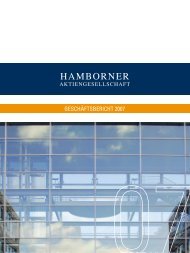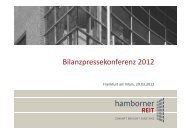annual report 2009 - bei der Hamborner REIT AG
annual report 2009 - bei der Hamborner REIT AG
annual report 2009 - bei der Hamborner REIT AG
Create successful ePaper yourself
Turn your PDF publications into a flip-book with our unique Google optimized e-Paper software.
Accounting and<br />
valuation methods<br />
Intangible assets<br />
Intangible assets are valued at acquisition cost,<br />
reduced by scheduled linear depreciations. The<br />
depreciations correspond to the economic life,<br />
which amounts to three to eight years.<br />
Tangible fixed assets<br />
Tangible fixed assets are valued at acquisition or<br />
construction cost, reduced by scheduled linear<br />
depreciations. We show proceeds from asset retirements<br />
un<strong>der</strong> the other operating income (profits)<br />
or the other operating expenses (losses).<br />
Properties held as a financial investment<br />
Properties held as a financial investment are valued<br />
by exercising the option in accordance with IAS 40<br />
(30) in conjunction with (56) for amortised acquisition<br />
or construction costs, taking into account linear<br />
depreciations. All undeveloped and developed properties<br />
as well as buildings and parts of buildings<br />
which are held for the attainment of future rental<br />
income, for the attainment of profits from appreciations<br />
in value and/or for an as yet undetermined<br />
use, are regarded as investment properties. They<br />
are not intended for administrative purposes or for<br />
short-term trade in the context of the normal business<br />
activity. Scheduled depreciations are carried<br />
out on a linear basis over the economic life. The<br />
result from the sale of the "properties held as financial<br />
investments" is presented in the profit and loss<br />
account in a separate item.<br />
For determination of the fair value to be indicated<br />
in the notes to the financial statements in accordance<br />
with IAS 40, we had our property portfolio<br />
valued by an independent expert at the end of<br />
<strong>2009</strong> in accordance with internationally recognised<br />
standards. Calculation of the property market values<br />
was carried out by means of the discounted cash<br />
flow (DCF) method. The cash flows to be expected<br />
in each case for the respective property were determined<br />
for a consi<strong>der</strong>ation period of eleven years<br />
– 2010 to 2020 – within the DCF process. The<br />
market value of properties results from the sum of<br />
the discounted cash flows of the overall planning<br />
period before tax plus the residual value also discounted<br />
on the valuation date. Risk-adjusted interest<br />
rates of 5.1 % to 8.35 % were applied for the dis-<br />
to our sHareHol<strong>der</strong>s management <strong>report</strong> Financial statements supplementary inFormation<br />
counting. Please refer to the section "Performance<br />
of the portfolio" in the management <strong>report</strong> for<br />
further information.<br />
Non-scheduled write-downs and write-ups<br />
of intangible assets, tangible fixed assets and<br />
properties held as a financial investment<br />
The recoverability of the amounts stated in the balance<br />
sheet is audited in sequence in the case of all<br />
intangible assets, tangible fixed assets and properties<br />
held as a financial investment. In addition, an<br />
audit of assigned values is carried out if events or<br />
changes to circumstances indicate that the book<br />
value shown in the balance sheet no longer appears<br />
achievable. Where the achievable amount of these<br />
assets significantly falls below the book value on the<br />
financial statement date, this is taken into account<br />
by means of non-scheduled write-downs.<br />
The net sales proceeds <strong>der</strong>ived from an active<br />
market or – if higher – the cash value of estimated<br />
future cash flows from use are taken for the determination<br />
of the achievable amount. In the case of<br />
investment properties, the market value determined<br />
by an expert constitutes the yardstick for the value<br />
in use. If the reasons for non-scheduled write-downs<br />
un<strong>der</strong>taken in previous years no longer exist, writeups<br />
are applied up to the amortised book values.<br />
The disclosure of non-scheduled write-downs is<br />
carried out un<strong>der</strong> the item "Amortisations of intangible<br />
assets, tangible fixed assets and properties<br />
held as a financial investment". Write-ups are<br />
entered in the other operating income.<br />
The result was reduced in the <strong>report</strong>ing year<br />
through non-scheduled write-downs amounting to<br />
€714,000 to adjust the <strong>report</strong>ed residual book values<br />
to the fair values applicable as of Dec 31, <strong>2009</strong>. On<br />
the other hand, a reversal of impairment adjustment<br />
for €1,266,000 was made for properties subjected<br />
to a non-scheduled write-down in previous years.<br />
Financial assets<br />
Financial assets are assessed at the fair value in their<br />
first valuation, in conformity with IAS 39, which<br />
takes into account the transaction costs on acquisition.<br />
The subsequent assessment depends on the<br />
category to which a financial asset is allocated.<br />
<strong>annual</strong> <strong>report</strong> <strong>2009</strong> | <strong>Hamborner</strong> reit ag<br />
77





